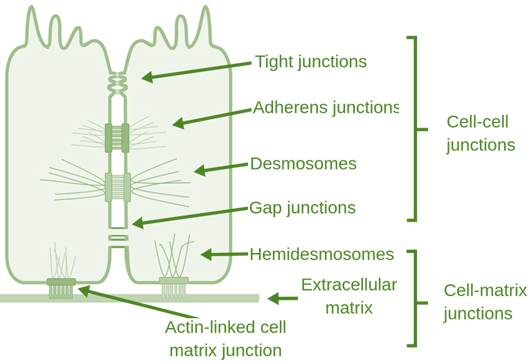- Cell junctions are specialized structures that connect cells to each other or to the extracellular matrix. These junctions play crucial roles in maintaining the integrity and function of tissues by allowing communication between cells, holding cells together, and regulating the passage of molecules between them.
There are three main types of cell junctions:

Tight Junctions (Occluding Junctions)
- Function: Tight junctions create a seal between adjacent cells, preventing the passage of substances between them. They are essential for maintaining the selective permeability of epithelial layers.
- Location: Commonly found in epithelial tissues, such as the lining of the intestines and blood vessels.
- Structure: Composed of proteins like claudins and occludins that form a continuous barrier.
Adherens Junctions and Desmosomes (Anchoring Junctions)
- Function: These junctions provide mechanical stability by anchoring cells to each other or to the extracellular matrix. They help tissues resist stretching and tearing.
Adherens Junctions
- Connect the actin cytoskeleton of one cell to another, important in maintaining the shape and tension of tissues.
Desmosomes
- Connect the intermediate filaments of one cell to another, providing strong adhesion between cells.
- Location: Found in tissues subject to mechanical stress, like the skin and heart muscle.
- Structure: Involve proteins such as cadherins (in ad
- herens junctions and desmosomes) that link to the cytoskeleton.
Gap Junctions (Communicating Junctions)
- Function: Gap junctions allow direct communication between adjacent cells by permitting the passage of ions, nutrients, and signaling molecules. This enables cells to coordinate their activities.
- Location: Found in many tissues, including cardiac muscle, where they facilitate the synchronized contraction of the heart.
- Structure: Composed of connexin proteins that form channels (connexons) between neighbouring cells.
Key Roles of Cell Junctions
- Barrier Function: Tight junctions prevent leakage between cells.
- Mechanical Support: Adherens junctions and desmosomes help tissues withstand mechanical stress.
- Cell Communication: Gap junctions enable the transfer of signals and molecules between cells.
These junctions are essential for the structure and function of tissues in multicellular organisms, contributing to everything from tissue integrity to coordinated cell behavior.
